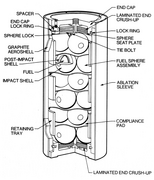Main article: Voyager program § Spacecraft design

Voyager 1 was constructed by the Jet Propulsion Laboratory.[12][13][14] It has 16 hydrazine thrusters, three-axis stabilization gyroscopes, and referencing instruments to keep the probe's radio antenna pointed toward Earth. Collectively, these instruments are part of the Attitude and Articulation Control Subsystem (AACS), along with redundant units of most instruments and 8 backup thrusters. The spacecraft also included 11 scientific instruments to study celestial objects such as planets as it travels through space.[15]
Communication system[edit]
The radio communication system of Voyager 1 was designed to be used up to and beyond the limits of the Solar System. The communication system includes a 3.7-meter (12 ft) diameter parabolic dish high-gain antenna to send and receive radio waves via the three Deep Space Network stations on the Earth.[16] The craft normally transmits data to Earth over Deep Space Network Channel 18, using a frequency of either 2.3 GHz or 8.4 GHz, while signals from Earth to Voyager are transmitted at 2.1 GHz.[17]
When Voyager 1 is unable to communicate directly with the Earth, its digital tape recorder (DTR) can record about 64 kilobytes of data for transmission at another time.[18] Signals from Voyager 1 take over 19 hours to reach Earth.[3]
Voyager 1 was commanded to change its orientation to measure the sideways motion of the solar wind at that location in space on March 2011. A test roll done in February had confirmed the spacecraft's ability to maneuver and reorient itself. The course of the spacecraft was not changed. It rotated 70 degrees counterclockwise with respect to Earth to detect the solar wind. This was the first time the spacecraft had done any major maneuvering since the Family Portrait photograph of the planets was taken in 1990. After the first roll the spacecraft had no problem in reorienting itself with Alpha Centauri, Voyager 1's guide star, and it resumed sending transmissions back to Earth. Voyager 1 was expected to enter interstellar space "at any time". Voyager 2 was still detecting outward flow of solar wind at that point but it was estimated that in the following months or years it would experience the same conditions as Voyager 1.[53][54]
Power[edit]
Voyager 1 has three radioisotope thermoelectric generators (RTGs) mounted on a boom. Each MHW-RTG contains 24 pressed plutonium-238 oxide spheres.[19] The RTGs generated about 470 W of electric power at the time of launch, with the remainder being dissipated as waste heat.[20] The power output of the RTGs declines over time (due to the 87.7-year half-life of the fuel and degradation of the thermocouples), but the craft's RTGs will continue to support some of its operations until 2025.[15][19]

